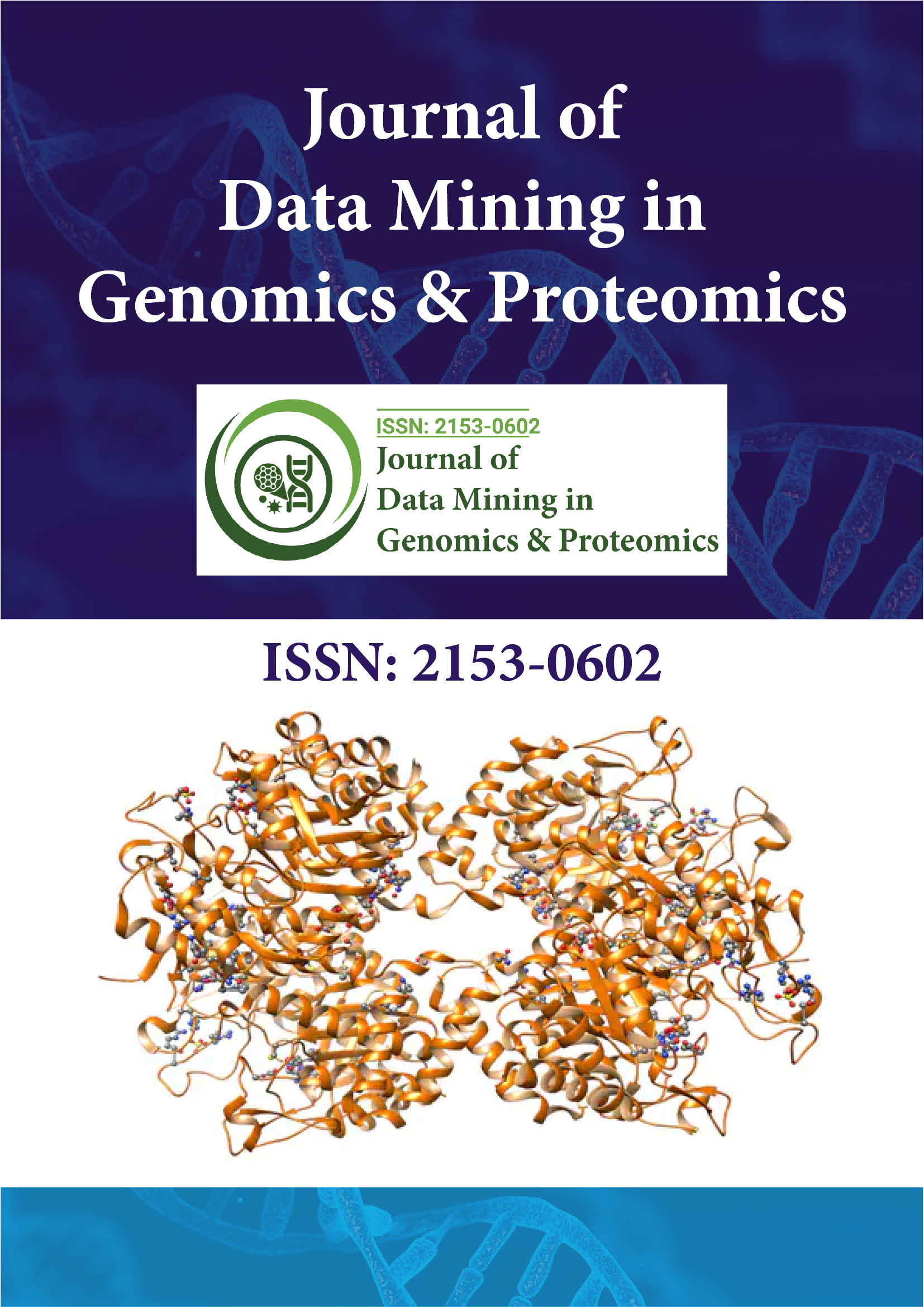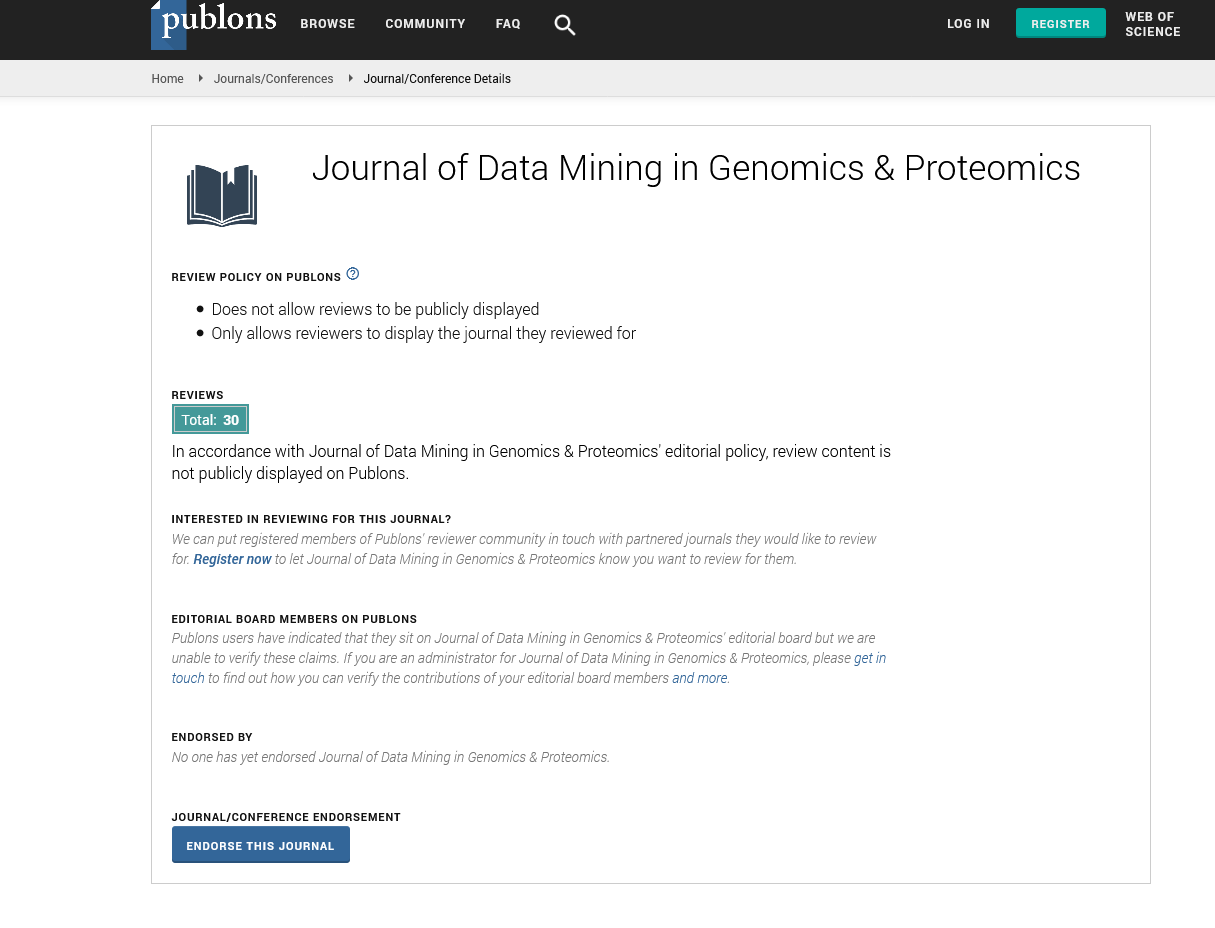Indexed In
- Academic Journals Database
- Open J Gate
- Genamics JournalSeek
- JournalTOCs
- ResearchBible
- Ulrich's Periodicals Directory
- Electronic Journals Library
- RefSeek
- Hamdard University
- EBSCO A-Z
- OCLC- WorldCat
- Scholarsteer
- SWB online catalog
- Virtual Library of Biology (vifabio)
- Publons
- MIAR
- Geneva Foundation for Medical Education and Research
- Euro Pub
- Google Scholar
Useful Links
Share This Page
Journal Flyer

Open Access Journals
- Agri and Aquaculture
- Biochemistry
- Bioinformatics & Systems Biology
- Business & Management
- Chemistry
- Clinical Sciences
- Engineering
- Food & Nutrition
- General Science
- Genetics & Molecular Biology
- Immunology & Microbiology
- Medical Sciences
- Neuroscience & Psychology
- Nursing & Health Care
- Pharmaceutical Sciences
Opinion Article - (2025) Volume 16, Issue 2
Integrating Genomic Data Mining for Rare Cancer Classification
Sofia Moreira*Received: 29-May-2025, Manuscript No. JDMGP-25-29764; Editor assigned: 31-May-2025, Pre QC No. JDMGP-25-29764; Reviewed: 14-Jun-2025, QC No. JDMGP-25-29764; Revised: 20-Jun-2025, Manuscript No. JDMGP-25-29764; Published: 28-Jun-2025, DOI: 10.35248/2153-0602.25.16.383
Description
Rare cancers represent a substantial fraction of global cancer cases, accounting for approximately 20% of all diagnoses. Despite their cumulative impact, the relatively low incidence of each individual rare cancer type presents significant obstacles for both research and clinical management. The scarcity of patient samples, coupled with considerable biological heterogeneity, makes it difficult to establish robust classifications, develop effective therapies, or conduct large-scale clinical trials. However, advances in genomic technologies and computational data mining are beginning to transform this landscape, offering powerful tools to unravel the molecular underpinnings of these uncommon malignancies. Modern high-throughput sequencing technologies generate expansive datasets that capture a range of genomic alterations, including point mutations, structural rearrangements and copy number variations. Computational mining of this data allows for the identification of recurrent genetic patterns, even within limited patient populations. These patterns often missed through traditional histopathological methods enable researchers to distinguish rare cancer subtypes with greater precision. For example, cancers that were previously grouped together based solely on histological features are now being reclassified based on shared molecular characteristics, leading to more accurate diagnoses and targeted treatment strategies.
Machine learning has played a critical role in advancing rare cancer genomics. Supervised learning algorithms can classify tumors into well-defined subgroups using labeled genomic features, while unsupervised approaches such as clustering and dimensionality reduction can reveal previously unrecognized subtypes. These methods are particularly effective at detecting nuanced molecular differences that may be invisible to standard diagnostic techniques. A notable example involves the reclassification of certain sarcomas into distinct subtypes based on unique gene fusions or mutational profiles, significantly influencing therapeutic decision-making. Integrating genomic data with transcriptomic information further enhances classification accuracy. While DNA sequencing highlights genetic mutations, RNA sequencing reveals how these mutations affect gene expression and regulatory pathways. This integrative approach helps differentiate between driver mutations with functional impact and passenger mutations with no biological consequence. By understanding how mutations manifest at the expression level, researchers can develop more biologically relevant models and identify therapeutic targets with greater precision.
Collaborative efforts at the international level have been instrumental in overcoming the limitations posed by small sample sizes in rare cancer research. Pooled genomic datasets from multiple institutions enable broader statistical analyses and increase the generalizability of computational models. Large-scale projects such as The Cancer Genome Atlas (TCGA) and the International Cancer Genome Consortium (ICGC) provide standardized, publicly accessible datasets that fuel comparative analysis and cross-cohort validation. These shared resources not only strengthen classification systems but also facilitate the discovery of novel biomarkers and therapeutic vulnerabilities. One of the most impactful applications of genomic data mining in rare cancers is the identification of biomarkers for targeted therapies. Many rare tumors harbor unique mutations that serve as actionable targets for existing or experimental drugs. Computational pipelines are now designed to cross-reference identified mutations with curated drug-response databases, such as the Drug Gene Interaction Database (DGIdb) or ClinicalTrials.gov. This strategy enables the repurposing of approved drugs for use in rare cancers, offering patients personalized treatment options that were previously unavailable under conventional protocols.
Moreover, the emergence of pan-cancer analysis frameworks allows for rare cancers to be studied in the context of broader genomic trends. By comparing molecular signatures across multiple tumor types, researchers can identify shared pathways and vulnerabilities, leading to therapeutic strategies that transcend histological boundaries. For example, tumors with microsatellite instability or specific kinase fusions may benefit from immunotherapies or kinase inhibitors, respectively regardless of their tissue of origin. Despite these promising developments, several challenges continue to hinder the full potential of data mining in rare cancer genomics. Variability in sequencing quality, inconsistent clinical annotations and batch effects between institutions can introduce noise and bias into analyses. Additionally, the computational infrastructure required to process and interpret large multi-omics datasets remains a limiting factor, particularly in under-resourced research environments. To address these issues, efforts are underway to standardize bioinformatics pipelines, improve data harmonization and adopt cloud-based platforms that provide scalable computing power.
Looking forward, the paradigm of cancer classification is steadily shifting from morphology-based to molecular-based taxonomy. As computational tools become more advanced and datasets grow more diverse, rare cancers will increasingly be defined by their genetic and epigenetic landscapes. This evolution is already improving diagnostic accuracy, expanding treatment options and offering new hope for patients who previously had limited therapeutic avenues. Continued investment in bioinformatics research, international data sharing and multi-omics integration is essential for sustaining this momentum. With these collective efforts, the once-daunting challenge of understanding and treating rare cancers is becoming increasingly manageable, paving the way for personalized medicine approaches that benefit all cancer patients regardless of how rare their diagnosis may be.
Citation: Moreira S (2025). Integrating Genomic Data Mining for Rare Cancer Classification. Journal of Data Mining in Genomics & Proteomics. 16:383.
Copyright: © 2025 Moreira S. This is an open-access article distributed under the terms of the Creative Commons Attribution License, which permits unrestricted use, distribution and reproduction in any medium, provided the original author and source are credited.

